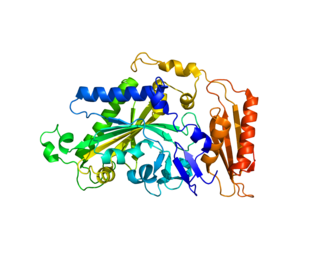Fatty acid 2-hydroxylase is a protein that in humans is encoded by the FA2H gene. [5]
Fatty acid 2-hydroxylase is a protein that in humans is encoded by the FA2H gene. [5]
This gene encodes a protein that catalyzes the synthesis of 2-hydroxysphingolipids, a subset of sphingolipids that contain 2-hydroxy fatty acids. Sphingolipids play roles in many cellular processes and their structural diversity arises from modification of the hydrophobic ceramide moiety, such as by 2-hydroxylation of the N-acyl chain, and the existence of many different head groups. [5]

Mutations in this gene have been associated with leukodystrophy dysmyelinating with hereditary spastic paraplegia type 35 (SPG35) with or without dystonia [5] as well as fatty acid hydroxylase-associated neurodegeneration. [6] The largest cohort with a detailed phenotypical description and a highly sensitive imaging phenotype ('WHAT'- acronym for: white matter changes, hypointensity of the globus pallidus, ponto-cerebellar atrophy, and thin corpus callosum) was recently published. [7]
FA2H has been shown to modulate cell differentiation in vitro . FA2H is may be a Δ9-THC-regulated gene, as Δ9-THC induces differentiation signal(s) in poorly differentiated MDA-MB-231 cells. [8]

L1, also known as L1CAM, is a transmembrane protein member of the L1 protein family, encoded by the L1CAM gene. This protein, of 200-220 kDa, is a neuronal cell adhesion molecule with a strong implication in cell migration, adhesion, neurite outgrowth, myelination and neuronal differentiation. It also plays a key role in treatment-resistant cancers due to its function. It was first identified in 1984 by M. Schachner who found the protein in post-mitotic mice neurons.

CYP27A1 is a gene encoding a cytochrome P450 oxidase, and is commonly known as sterol 27-hydroxylase. This enzyme is located in many different tissues where it is found within the mitochondria. It is most prominently involved in the biosynthesis of bile acids.

The human gene SPAST codes for the microtubule-severing protein of the same name, commonly known as spastin.

85 kDa calcium-independent phospholipase A2, also known as 85/88 kDa calcium-independent phospholipase A2, Group VI phospholipase A2, Intracellular membrane-associated calcium-independent phospholipase A2 beta, or Patatin-like phospholipase domain-containing protein 9 is an enzyme that in humans is encoded by the PLA2G6 gene.

Paraplegin is a protein that in humans is encoded by the SPG7 gene located on chromosome 16.

Kinesin family member 5A is a protein that in humans is encoded by the KIF5A gene. It is part of the kinesin family of motor proteins.

Non-imprinted in Prader-Willi/Angelman syndrome region protein 1 is a protein that in humans is encoded by the NIPA1 gene. This gene encodes a potential transmembrane protein which functions either as a receptor or transporter molecule, possibly as a magnesium transporter. This protein is thought to play a role in nervous system development and maintenance. Alternative splice variants have been described, but their biological nature has not been determined. Mutations in this gene have been associated with the human genetic disease autosomal dominant spastic paraplegia 6.

Phenylalanyl-tRNA synthetase, mitochondrial (FARS2) is an enzyme that in humans is encoded by the FARS2 gene. This protein encoded by FARS2 localizes to the mitochondrion and plays a role in mitochondrial protein translation. Mutations in this gene have been associated with combined oxidative phosphorylation deficiency 14, also known as Alpers encephalopathy, as well as spastic paraplegia 77 and infantile-onset epilepsy and cytochrome c oxidase deficiency.

Spatacsin is a protein that in humans is encoded by the SPG11 gene.

CYP4F22 is a protein that in humans is encoded by the CYP4F22 gene.

CYP2U1 is a protein that in humans is encoded by the CYP2U1 gene

Homeobox protein Nkx-6.2 is a protein that in humans is encoded by the NKX6-2 gene.

AFG3 ATPase family gene 3-like 2 is a protein that in humans is encoded by the AFG3L2 gene.

Acetyl-coenzyme A transporter 1 also known as solute carrier family 33 member 1 (SLC33A1) is a protein that in humans is encoded by the SLC33A1 gene.

Zinc finger, FYVE domain containing 26 is a protein that in humans is encoded by the ZFYVE26 gene.

Zinc finger, FYVE domain containing 27 is a protein that in humans is encoded by the ZFYVE27 gene.
NADH:ubiquinone oxidoreductase complex assembly factor 5, also known as Arginine-hydroxylase NDUFAF5, or Putative methyltransferase NDUFAF5, is a protein that in humans is encoded by the NDUFAF5 gene. The NADH-ubiquinone oxidoreductase complex of the mitochondrial respiratory chain catalyzes the transfer of electrons from NADH to ubiquinone, and consists of at least 43 subunits. The complex is located in the inner mitochondrial membrane. This gene encodes a mitochondrial protein that is associated with the matrix face of the mitochondrial inner membrane and is required for complex I assembly. A mutation in this gene results in mitochondrial complex I deficiency. Multiple transcript variants encoding different isoforms have been found for this gene.

AP-5 complex subunit zeta (AP5Z1) is a protein that in humans is encoded by the AP5Z1 gene.

AP-5 complex subunit beta (AP5B1) is a protein that in humans is encoded by the AP5B1 gene.

AP-5 complex subunit sigma (AP5S1) is a protein that in humans is encoded by the AP5S1 gene.